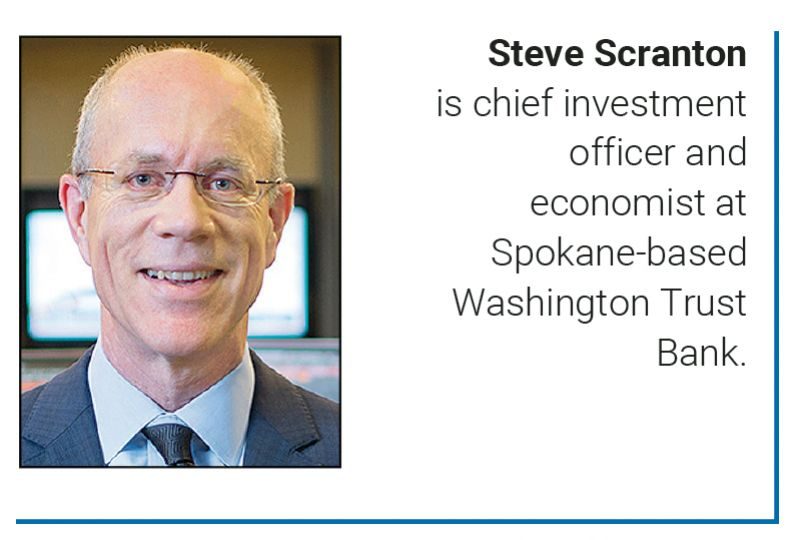
Home » Inflation significance varies with individuals
Inflation significance varies with individuals
Trend probably more self-correcting than spiraling

June 21, 2018
The topic of inflation has begun to receive more attention from the media, economists, policy makers, and the Federal Reserve. The reason for this heightened interest is that the official measure of inflation is approaching the Federal Reserve’s target level.
First, what is inflation and why should you care? In its simplest terms, inflation measures the cost of living. There are various ways to measure inflation, but the most common and widely used is the Consumer Price Index.
CPI is calculated and reported by the U.S. Bureau of Labor Statistics to measure the change in prices paid by consumers for goods and services. The intent is to identify how much the cost of living has changed for the average American.
Unfortunately, the inherent problem with trying to produce a national measure of inflation is that inflation is unique to each individual. Everyone may buy some of the goods and services that are included in the CPI calculation, but no one buys all of them or in the same proportion as the index.
Consider examples of how two people could have dramatically different inflation rates based on the latest published data from April 2018.
Food: Based on the CPI data, if you purchase groceries and eat most of your meals at home, your inflation for food rose 0.5 percent versus a year ago. If your neighbor ate most of their meals away from home, their inflation rate for food was 2.5 percent.
Energy: If you heated your home with fuel oil, then you saw your energy prices rise by 22.6 percent; if your neighbors heated their home with electricity, they saw their energy price rise by only 1.2 percent.
Medical: Medical prices varied depending on what type of doctor you saw. The inflation rate for physician services only rose 0.3 percent compared to the price for dental services, rising 4.1 percent.
Transportation: At first glance, it appears that everyone benefited from public transportation costs declining 3 percent, until you see the difference in the type of transportation. Airfare declined 6.9 percent, while intracity mass transportation rose 2.6 percent.
Fuel: If you drive a vehicle that uses regular unleaded gas, you saw your fuel cost rise 13.5 percent from a year ago, but if your vehicle used diesel, the price rose 19.1 percent.
The point of these examples is that there is no universal inflation rate. Quite often, the news on CPI may be puzzling if your own cost of living rose or fell more than the published number.
In reality, however, the national number matters even if it doesn’t reflect your situation accurately.
Many rent and lease rates are adjusted based on CPI. If inflation is rising, rent and lease payments tied to CPI rise. That might be good for property owners, but for tenants it means higher monthly payments that can be painful unless their income is rising as fast.
Many income-support programs, such as Social Security, adjust based on CPI. Inflation matters for recipients since their income will rise or fall with inflation. The problem is that the income adjustment is tied to the national inflation number, while the individual’s expenses probably won’t match that change.
This was made painfully clear over the past 10 years when incomes didn’t increase at the same pace as many people’s expenses. With the advent of the “Amazon effect” and automation, CPI has been historically low during this business cycle while some expenses—like medical expenses—have risen faster than CPI. If spending habits are built around assuming a certain level of annual increase, anything less could have a negative impact on that person’s lifestyle, unless they can adjust expenses accordingly.
As part of its charter, the Federal Reserve is mandated to maintain stable inflation. Although the Federal Reserve looks at a different inflation index—the Personal Consumption Expenditure index published by the U.S. Bureau of Economic Analysis—price movements are closely correlated.
Some now worry that the Federal Reserve will raise interest rates at a faster pace if the pace of inflation increases beyond its target rate. The concern is that the Federal Reserve will rely on historical academic models that might not fit the current environment, resulting in raising rates too aggressively and hurting economic growth.
One point to consider is that there may be two types of inflation—self-correcting inflation and spiraling inflation. The inflation problems from the 1970s and ‘80s were due to spiraling inflation. During that period, more of the workforce were union members or had cost-of-living adjustments built into their salaries. As prices went up, wages went up as well, and demand continued for higher priced products. The Federal Reserve ultimately had to raise interest rates dramatically and put the economy into a recession to break the spiraling inflation trend.
Today, cost-of-living increases for wages are a rare feature. Even with union jobs, the focus has favored job security over inflation protection. In that scenario, if prices rise, consumers may scale back on purchases. Demand for goods and services will drop, excess supply will develop, and businesses will drop prices to sell the excess supply, creating a self-correcting inflation environment.
For now, the inflation rate hasn’t risen sufficiently to spur Federal Reserve action. That doesn’t mean that your inflation rate has behaved the same way. Consider using the CPI as a guide for developing inflation trends and as an indicator of how sentiments may shift among clients and staff, from maintaining awareness of pricing trends for products and services to updating employee salaries and benefits to remain fair. Plus, if you’re planning on expanding or reinvesting in your business, tracking the CPI can indicate whether your goals are growing more or less expensive.
Latest News Special Report Banking & Finance
Related Articles

![Brad head shot[1] web](https://www.spokanejournal.com/ext/resources/2025/03/10/thumb/Brad-Head-Shot[1]_web.jpg?1741642753)

